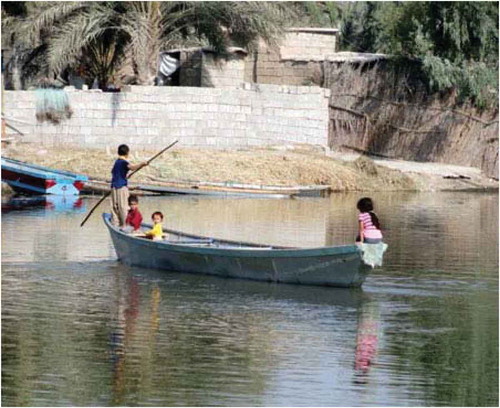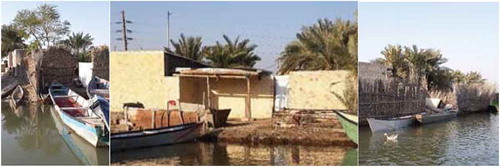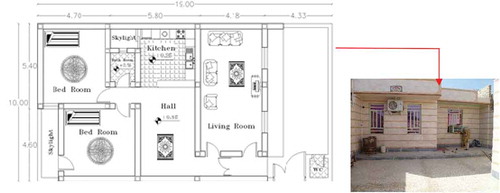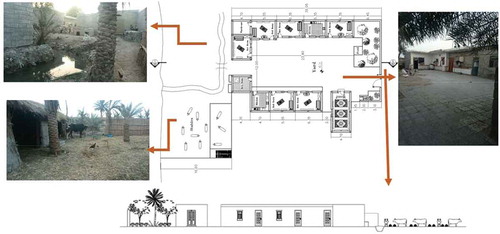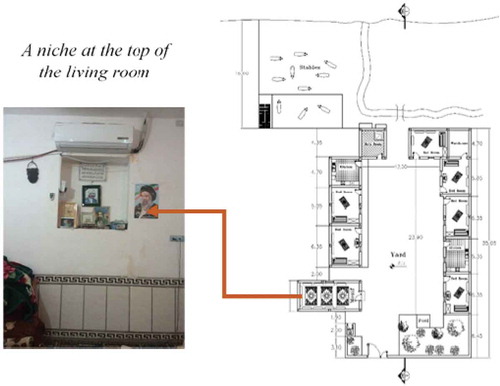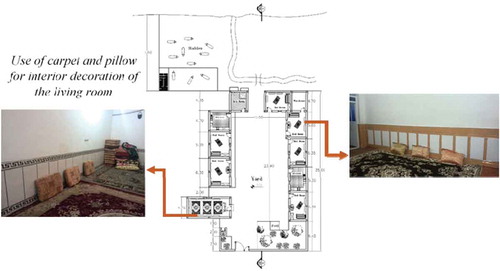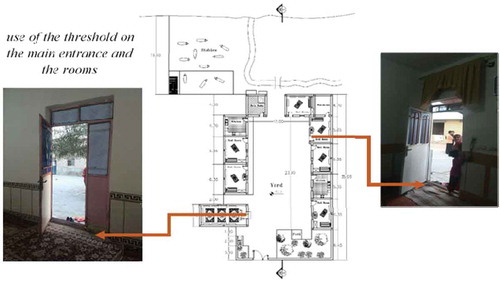Abstract
The settlements are designed, built and used by people. The way of deployment and location, its growth and its changes depend on the behaviour and lifestyle of its inhabitants. Housing is one of the basic human needs and is part of the overall rural identity, and any changes in its pattern will create a widespread transformation in the various dimensions of the life of rural households. For this reason, design for villagers requires comprehensive planning based on regional knowledge. The purpose of the research is to investigate new rural construction and its adaptation to the local architecture of pond villages. Various tests such as Cochran formula, t test, Pearson test and multiple regression test were used to study the adaptation of new construction with local architecture. The results of the research show that local architecture has the greatest effect on the survival of residents in the village and their satisfaction.
Public Interest Statement
One of the most important elements of the village is the pattern of its settlements that expresses traditions, livelihoods and economic trends. Therefore, any changes in it will bring about a massive transformation in the lives of rural households. One of the problems of Khuzestan pond villages is the lack of attention to the design proportional to the village culture. The aim of this research is to investigate new rural construction and compare it with the native architecture of pond villages. This research is in the Sarakhiyeh village in Khanafereh in the Shadegan city. The results of the research show that native architecture is effective in improving village body quality and that tradition and culture have the greatest impact on the lack of immigration of residents in the village.
1. Introduction
Rural housing under the influence of needs and requirements of socio-economic aspects of rural life and the nature of social relations of rural households has multifaceted status. So housing in a village context is part of the overall identity of the village (Amar & Naeij, Citation2011). In fact, traditional rural architecture originates from traditions that exist unconsciously within the culture of a nation (Wells, Citation1995). In this study found that rural housing over the long years and according to the needs of residents in each district came into existence, and since architectural features of each region are different modernization should be paid adequate attention (Abdollahi, Buzerjamhari, & Soltani, Citation2015). However, the architecture and indigenous patterns of new housing units in rural areas vary widely and rather than rural, they resemble similar urban new models. Diversity of housing and change creation has clearly changed the face of rural areas and has created different problems in them. In general, rural housing modernism in architecture is a stroke that could change housing rural communities from the shape of their identity (Movahed, Citation2015). Over the past few decades, policies and programmes of government have caused some changes in rural areas especially in physical dimensions. Executive managers design regular networks and structures with mud and stone because they believe village constructions lack a proper engineering system, They consider it unimportant and believe that the villagers just need a shelter with resistant materials and do not need construction based on local architecture. An underlying issue is that any policy and planning of rural housing in the country can be deemed successful when the plans and actions with the features and characteristics of rural architecture comply with the traditions of ethnic, cultural and ecological diversity found in different parts of the country (Eftekhari, Abdolreza, Fatehi, & Paydarkolsang, Citation2012).
Pond villages in Khuzestan are from this category, despite having a native features arising from climate, historical traditions and there Shadegan pond, in the construction that the government is custodian, the capacity of the field is ignored that is the cause of problems such as the rural migration. The new architecture of buildings as well as the physical layout leads to alienation and lack of participation of indigenous peoples in the designs. The main research question is the reason of the failure of existing schemes in the pond villages, which is the major problem of these villages, as well as ways to fix these problems and avoid migration. So this study seeks to answer the question of how the new constructions can match with rural architecture in Khuzestan pond villages? And what are the factors affecting the consent of the indigenous peoples from government interventions in the pond village construction of Khuzestan? Due to natural capacity, the Sarakhiyeh village of Shadegan city functions has been selected as the case study of this research.
2. Theoretical
In rural communities, while tradition has a life force, dynamics and stability, this structure works well. The creation of new housing patterns is the sign of the effect of tradition. Hojat in his studies about rural housing of Iran concluded that in the early years after the land reform, there were no major changes in the method of construction of rural housing and rural homes with the same methods and indigenous materials were built only in the wider context. Gradually, relations of the villagers with the city and methods and materials commonly that used in city, has effects on the structure and form of rural housing. Replace bricks instead of the adobe to build the wall, Popularization prevailing latest waterproofing (bitumen and packages) to cover the roof and the use of recycled metal windows from demolished structures in the city is collected in the buildings view, examples of incremental change the face of village after land reform is considered (Movahed, Citation2015). Rural houses that once reflected the traditions and customs of the village now bear no resemblance to neither rural homes nor modern urban homes (Zandiyeh & Hesari, Citation2011). In fact, villages are in danger of invasion plans and the so-called urban homes and do not conform with basic living and rural traditions (Gallent, Citation2009). Rural buildings at all the time was function to the geographical environment, local resources, traditions, customs, values and culture of the people according to their own needs, that they have created and all of those proposals, technology and style of effectiveness and human relationships with the natural environment experimental facilities and over time has been. Indigenous rural architecture has a direct connection with the culture of the people and their everyday life that simplicity has a certain complexity and were made by people who have used all the intelligence and capacity, until their homes have acceptable all the needs of homes and way of life. Most of these models are made based on economic conditions and weather conditions of the area and are acceptable to all rural communities. In fact, the most fundamental difference between rural and urban housing is the livelihood fusion of production and life in rural homes (Zandiyeh & Hesari, Citation2011). Construction on the vernacular architecture of different ways has changed the lives of rural people; Important cases can be economic aspects, when local building materials and labour are family members and neighbours, as a result, construction will be low cost. The new architecture has many differences with indigenous patterns which have changed form and organization of rural residential areas and have been causing disharmony with the needs of living and working of villagers, and of course it is undeniable that people who tend to turn to the new architecture also have raised this issue. Another important issue is the general impression that local materials do not have the required strength; there also exist resistant and durable materials in a range of colours and that are beautiful that their use alone or in combination with new materials can give diversity, strength and beauty to the materials. But because people have little knowledge, local materials have been less welcome. The most important criterion of housing satisfaction by many villagers is the strength of building that it tends to be the most important factor of orientation to new housing, but some others prefer comfort in relation to climatic conditions. However, building strength is a key factor in creating favourable housing, but lack of attention to natural environment, traditions and culture caused confusion and contradiction in the rural context. Despite all cases where we have expressed the need to strengthen rural housing, the least housing quality index in the villages of Iran is the index of durable materials (Eftekhari et al., Citation2012).
3. Research method
The method is based on analytical-descriptive survey. In order to collect information from different methods of documentation, library and field are used. Also the data contained in the Housing Foundation of Shadegan city and at the end a questionnaire and interview process was used. The Statistical Society of study consisted of families living in the Sarakhiyeh village of the city Shadegan. The correct relationship of planners with people is the best way to achieve a correct understanding of the will of the people, issues and problems of the village and of public participation in the preparation of the plan. That is why researchers have tried to achieve this goal by providing an optimal situation by designing different questionnaires and interviews. For this purpose, factors influencing quality of life in the lagoon have been noted. In the questionnaire, to estimate the statistical society size of the total population (according to the 900-person census of Sarakhiyeh) the model Cochran was used, and the number of samples obtained in accordance with the results of this model is 270. Since there is a possibility of returning the questionnaires, 400 questionnaires were distributed, of which 387 were answered. According to the initial measurement of the number of users of space, a preliminary questionnaire (387 samples) at different times of the day between the people and the various segments was distribution, and the validity of the questions was confirmed. Finally, the raw data obtained were classified using SPSS software and 95% confidence levels were analysed. To analyse and assess the validity of the questionnaire and the assessment of the suitability of analytical instruments, reliability of alpha coefficient of questions was calculated and the alpha coefficient of all questions was greater than 0.7 which confirmed that the model used to assess the impact of vernacular architecture has a great accuracy on the rural physical quality promotion. To calculate the average key metrics to measure the impact of physical and socio-cultural features in the local architecture, one-sample t test was used, to determine the correlation between the factors taken into consideration, the Pearson test was used, and to study the effects of all independent variables (vernacular architecture) on the dependent variable (quality of life and landscape design, urban and rural), multiple regression method was used.
3.1. Area of study
Sarakhiyeh village in political terms is a rural function of Khanafereh in the Central District of Shadegan city, Khuzestan Province. Sarakhiyeh village from east by the Rogbeh village and from other directions restricted by ponds (Figure ) (OFHIS [Organization of Foundation for the Housing of the Islamic Iran revolution of the Shadegan city], Citation2013).
The Sarakhiyeh village, like other villages in the city, is located in the pond; But Special Position of it in the lap of the pond is what of distinguish this village from other villages in the region and introduced as a model village. Today, this village due to the inclusion of several islands within the pond is taken into consideration and shows unique species of habitation. Thus, the village due to its unique spatial location and appropriate place for introducing features of the Shadegan pond is considered as an ecotourism location. These makes the implementation of tourism projects in the village and construction of the boat ride pier for attract tourists and are resorts being built at the entrance of the village, that is the most important physical changes of the village. Villagers must use their boats to move and go to other parts of the village (Figure ) (OFHIS, Citation2013).
These boats in the lagoon are used for moving, transportation of livestock, forage and fishing. Each of the rural houses has a dedicated small beach which the villagers use for their boat movement on the water. This place is mostly part of their yard and in fact we can say their yard is a beach of the pond. The boat movement in the pond is a good view and a beautiful showcase of the rural livelihoods (Figure ). The main part of the Sarakhiyeh village economy is the animal husbandry and fishing that the buffalo breeding has special importance, in addition to the needs of rural residents, surplus livestock products such as milk and cheese sold in the Shadegan city.
3.2. Principles and fundamental concepts in new and old works, the dominant pattern of housing in the village and the causes and factors affecting its formation
Among the satisfaction factors, quality of construction in the research is divided. This quality, in the sense of how to build and plan a concept, is consistent with the local architecture and involves supervising indicators such as compatibility with living conditions and lifestyle of location. At this point, check out researchers’ principles and fundamental concepts of architecture in new works and compare them with what’s old. The study is important because the residents’ satisfaction of construction on the basis of traditions and culture of the region and also conformity of the architecture with local buildings lead to lack of migration of villagers from their homes. Construction, consistent with creating a visual view can have a convenient impact on the physical quality of rural areas. Since the livelihoods of rural households is dependent on livestock and fisheries and ponds, the physical shape of the housing, the placement of spaces and their relationship manifested, these issues has a decisive role in the creation of the design patterns, and that is why there is non-compliance design options of the construction for rural residents, in addition to discontent and damaging the economy and their livelihoods. According to the location placement of the village in the Shadegan pond, these houses are more similar to the rural homes and reflect the customs and traditions of the residents of the village, in addition to creating more memories for villagers, thus attracting tourists; the village has become a destination resort and has an impact on rural economic growth. In fact, converting the village into a tourism hub, in addition to the previous items increase the life quality of villagers, and further attention to the cleanliness and design of furniture also create a sense of belonging and prevent migration. Read more on the survey results.
The sample given in Figure relates to new homes. The use of ceramic facade leads to a lack of harmony with nature and failure to comply with the local architecture. Lack of use of water and flowers in the yard, lack of proportionality and diversity of spaces and climate conditions are the other issues that are paid less attention in the new constructions. Open kitchen in these houses is less used and all the cooking is done in the backyard or garden. Since rural households live a productive life and maintenance of animals in a part of the yard is done, the embedded space as barn in part of the yard is very important which is ignored in this new design thus endangering the economic status of rural households. Factors affecting the development of the prevailing pattern of housing, such as natural, economic, social and cultural factors, somehow affect the formation of the dominant paradigm of the shell and housing. Here, we will review two models of residential homes. The first model is a situation in which the livestock is kept as part of the house yard and the second pattern in which the livestock whereabouts are separate from residential unit and are in the second courtyard. The first model: In recent years with regard to the fundamental transformation of rural housing and construction materials as well as construction plans, construction of residential space has been experiencing substantial changes. Because the old residential units were used for maintenance of animals and new residential units have been built with new materials, the separation between livestock space and residential space is very evident. Communication and performance (communication inside and outside) especially alleys, according to the traditions, culture and traditions of each family, relationship of residential units with public space of alleys will be done in several ways. Entrance has no home concept in the village and generally there is reed fence around the house, the engulfed parts of which are open and act as entrance. Sometimes the house has no clear fence clear and natural boundaries such as ponds determine the yard area. The main place of courtyard in the residential units is in the centre. The yard is a large space and various functions are arranged around it. Courtyard not only connects all spaces with each other, but also includes community residents and even livestock activities in the units. Different areas such as rooms, barn, oven, kitchen and garden are built around yard and generally barn of buffalo without fence is beside the yard. There are no specific dimensions, and only the geometric form is nearly a square. If the family is large and has the ability to pay, the yard is made larger. Sometimes a large courtyard is divided between the multi-family and turns into smaller yards. Communication of closed spaces (room and kitchen) is a direct relationship without intermediaries. Courtyard is placed in the centre in terms of not only performance, but also of communication. Access to the rooms is possible only through the courtyard and in most cases even access between two adjacent rooms without crossing the courtyard is not possible. Private living space per household in a dwelling is limited to a maximum of two rooms. For this reason, the functions of a room in this style of residence are diverse. Rooms are generally a barn, kitchen, bedroom etc. Part of the room that is farthest to the entrance is used as warehouse. Near to the entrance of the room, the needed equipment for the kitchen is located and the remaining space generally covered by mat, rug or carpet has been used as a private space.
The level of the room window is low and has a view of the courtyard. Generally, for reasons such as lack of security, room conservation from the perspective of alien and lack of funding, the windows cannot be opened on the street. Floor of rooms is generally made of plaster or mud. The walls are also generally covered with plaster. In homes with lower income levels, the walls of the room are covered with mud while in some houses the walls are covered by plaster. Wooden beams and sometimes tubes of iron and mat are used for the roof of rooms. In general, low light and relatively dark rooms with bulky and heavy walls and openings for ventilation that is embedded in the walls compared with extreme heat and harsh climatic conditions are suitable for living. It is notable that rooms built with blocks do not have compatibility in the air region and according to residents on hot summer days they are not habitable and require the use of cooling devices, such as fans and air conditioning. On the day for cooling the floor of room, water is sprayed and after drying, mat or rug are broad. “Mozif” is the local name of the guest living room. Although Mozif used as a living room and guest house but according to tradition and local culture, its own performance. So that is tried, as much as possible, to be separated from the private spaces and in some cases it is built as one room out of the house. Sociological studies are needed to investigate this matter. In short, it seems that long ceremony weddings, celebration and mourning or abounds of leisure and unemployment of men are reasons for this. Mozif is the best room of the house and building materials depend on the effort of homeowner. Mozif usually has one or more windows that unlike other rooms are usually open to the public roads. The windows are made of iron or wood and often its view is completely closed and also its glass has stained. Mozif location depends on the financial situation and lifestyle of homeowner. Mozif of Sheikhs and those who can afford is more generally outside the dwelling and Mozif of ordinary people is made within the dwelling. Communication of Mozif sometimes from the yard and interior space of home, and sometimes from the input space of home is created that in some cases, view of the courtyard is limited by the side walls. In some cases, Mozif entrance is independent of the entrance of courtyard and is directly related to the alley. Sometimes the Mozif has two doors, one that opens to the courtyard and the other that directly opens to the street. Coffee ceremony is performed in Mozif. Barn is said to be the livestock space. In the Sarakhiyeh village, the type of trap is the buffalo, barn is a covered area, that its ceiling light made of straw and palm wood and is based on the pillars of clay or space is large and enclosed that made of mud walls and ceiling light and is built in a corner of the yard. This sample shown in Figure relates to the plan of the old houses and the first pattern. In addition to the previous cases, these houses are in more harmony with nature, and interiority and centrality are the other features of these houses. The yard is the entertainment hub of the home and all their daily activities. Using water and plants in the yard creates a sense of calm and vitality to residents. Iranian house yard is the vibrant atmosphere of the house. Most flow of life happens here. Yard is full of children’s noise and women hum and work together to meet the needs of households; right from the goldfish in the pool until birds that nest on the trees, all reside in the yard. Finally, yard is a life for the body of Iranian architecture. Iranian house without “yard” does not have “life” (Misaghiyan, Citation2013).
Figure 5. Plan of old houses that whereabouts of animals is part of the yard
(Reference: Authors 2016).

The second pattern: Check the human settlements of village affected by economic factors, and the canvas of life and way of living is possible. The thing decisive in this regard is the way of living and traditions of livelihood. Given that livelihoods of rural households is based on animal husbandry and agriculture, the body of the housing, in the placement and communication of spaces and also number of rooms and storage is manifests and in this case a greater level of home and its position, in this respect is crucial, so when the family livelihood is based around livestock, residential space is composed of two types of animal and human space and these spaces (livestock) in the household non-farmers does not exist. Another case to be seen in rural architecture is practices tribal culture in the rural system, the son of the family after marriage, makes his home, in part of area of parents home and by adding new people, more space is created; but in recent years this trend with regard to the independence requirements of the new households, has changed, because the new housing makes after the formation of a new family and fewer cases seen in a multi-family housing units to live as a family. House in the village has taken Bio-production shape, so that the people engaged to manufacturing in the part of the house (livestock) and in the other part, activities of life (human) is established, But any activity in the livestock sector, there are not a nuisance for other parts of the house and vice versa; But because of the value of livestock at the village level that caused the profitability of the livestock, animal spaces has not less quality from the human spaces and in some cases spaces of animal has more quality than human spaces. In the design of rural settlements, a space is necessary to save the product and this space is split into two categories, long-term storage for feed and short-term storage for storing everyday items, so we can conclude that short-term storage should be near and linked to human space. In this model, two courtyards, one for the animals and the second for humans, that service spaces such as warehouse and barn have been separated from each other. But the relationship between these two yards is accessed from inside of the warehouse. The sample shown in Figure relates to the plan of old houses and the second pattern.
The sample shown in Figure relates to the niche in the living room that is phenomenon of functional and decorative at home and according to the operation that there, could be has a shape, texture, materials and cases are different. In this house, a niche at the top of the room is unique to the Bible and equipment is associated with beliefs and family photos. The niche duty in this sense is a place to keep and display the favorite cases, that can create a pleasant feeling.
Figures and also, respectively, show the use of carpet and backrest for internal decoration and variation in colour of the interior walls of the living room.
The sample shown in Figure relates to the door threshold that is at the bottom of the frame.
The driveway and the entrance to the room can be seen.
This threshold creates a shift in the human body (slightly going up and then coming down). Also for more complete separation of the two spaces, the threshold is used.
Creation of design options is based on the phenomena discovered.
At this stage, from the studied design options, we can choose the closest plan to maintain customs and local architecture. Positions of these options are specified in Table :
Table 1. Options of design based on the discovered phenomena (Reference: Authors 2016)
3.3. Research findings
The results of the t test (Table ) show that the main hypothesis is true and H0 is rejected and vernacular architecture is effective to enhance the physical quality. Also according to the analysis conducted, in most variables measured, with 99% there is a significant relationship. (Sig <0.05) results showed that the criteria interference average of environment in general is equivalent (2.82) that is near to 3 (average of determined worth) and represents the impact on improving the physical quality is evaluated vernacular architecture. As can be seen, according to the criteria average from the opinion of citizen, security, dependence of residents to the village, tradition and culture of the region have the most impact in no-immigration of residents in the village and satisfaction of them. The results of these tests and interviews with residents revealed that the lagoon is one of the factors that causes creation of the village and staying of the residents. But the authorities and relevant organizations do not pay attention to environmental issues and safety of residents, and this caused discontent and there has been a lot of problems. The most important problem of reducing or lack of tourist attraction in the area is no-construction based on local architecture. Given that the international pond of Shadegan is one of the largest ponds in the Middle East and can attract maximum tourists to be turned a place of leisure and to be the economic growth of the village and even Shadegan city have contributed. So the design and rebuilding of the village based on vernacular architecture, as well as providing the necessary conditions and facilities for tourist attraction, can satisfy the needs of residents. The standards of cleanliness, furnishings and recreational space have the lowest average. In fact, the most needs of residents that's it, because the contact of these components with vernacular architecture is in the opposite direction, accordingly it was considered in the design of questionnaire the satisfaction of residents that the majority declared their dissatisfaction. The first column of the left are variables, the second column is statistics “t”, the third column is the degree of freedom for each variable and the fourth column shows significance. Considering the significance level for most variables is less than 0.05, we conclude that each of the variables is significantly different with the number 3. The fifth column is the mean difference of each variable in the sample with the number 3. The last two columns represent the upper and lower limits for the mean of each variable. Due to positivity and limit of upper and lower of all the variables, the average of them is higher than number 3. So considering the above, it is concluded that the above variables are highly effective in improving physical quality (Prove hypothesis). To determine the correlation between the factors taken into account, the Pearson test was used. Pearson coefficient is always between +1 and −1. The Pearson coefficient increases and is closer to 1, and two variables have greater solidarity and positive and negative marks indicate the correlation relationship and reverse. According to the results of Pearson tests and interviews, choosing a living place, creates a large correlation with the fulfill subsistence needs, customs and traditions and to dependence. For this reason, to prevent the migration of residents, and to fulfil the purpose we should make a true plan. As was said in the t test, one of the best ways to make money in the village is attracting tourists by providing welfare and recreational facilities and also to create a sense of belonging of the people to the village, and all the design and construction should be done based on indigenous customs and architecture of this region. In addition to the foregoing, the sense of security, cleanliness (how garbage collection is done, sewage disposal and surface water), furniture (benches, trash, telephone booth, etc.) and other recreational facilities can have considerable influence on the development of a sense of belonging to the resident’s life. Now most of the income of rural residents is provided through hunting and fishing in the pond. But since the government and relevant organizations do not care to address the issues of environmental and cleanliness of their village, disposal of garbage and wastewater in the lagoon leads to the loss of fish and lowers the income and for this purpose the right place must be to chosen to collect and landfill to minimize the damage. In fact, maintenance of ponds is important to choose where the residents live and are dependent. In proof of the above, the numbers in Table show the priorities and related indicators of the desired effect with the index local architecture that participation, the current appearance of villages and buildings constructed by the Housing Foundation is most relevant to vernacular architecture; Indicators such as furniture, flooring, sense of security, recreational, interactions, leaving the village with vernacular architecture is an inverse relationship.
Table 2. The results of t test (Reference: Authors 2016)
Table 3. Pearson coefficient of tested components (Reference: Authors 2016)
3.4. Multiple regression analysis
In Table , values “t” of all of regression coefficients are calculated and they also mark a significant level. As the last column of the table (sig) shows three indicators of participation, the current appearance of villages and buildings under the Housing Foundation with confidence 99% on the preservation of vernacular architecture and is impressive ultimately affect the quality of urban and rural landscape and the index of cleanliness of the village, the lowest level is significant.
Table 4. Regression coefficients (Reference: Authors 2016)
4. Conclusion
From the viewpoint of the researchers, appropriate settlement must be done, by which a man can achieve happiness and perfection, and they believe that live, build, grow and develop are synonyms. Therefore, this article has been looking for how new constructions can be consistent with vernacular architecture in rural areas and pond construction of Khuzestan? And what are the factors affecting the consent of the indigenous peoples from government interventions in the construction? According to research findings, new constructions in the village are not on the basis of the pattern vernacular architecture, because new patterns have no resemblance to rural people’s lives and are affected from urban patterns. Indigenous villagers’ knowledge in the field of architecture rural living is the result of centuries of experience in an environment, and therefore is compatible with all environmental conditions. So, rustic architecture copies urban architecture and does not follow the norms and customs of rural culture, and this creates visual confusion and lack of coordination housing with his floor and also causes creation the social, cultural, ecological and economic damage. One of the important issues in recent years that causes problems in the village and the migration of a large number of residents is due to lack of construction lack based on traditions and local architecture. According to the results of Pearson tests and interviews, choosing a living place, creates a large correlation with the fulfill subsistence needs, customs and traditions and to dependence. For this reason, to prevent migration of residents, we must be able to fulfil this target. Participation, the current appearance of villages and buildings constructed by the Housing Foundation is most relevant to vernacular architecture; Indicators such as furniture, flooring, sense of security, recreational, interactions, leaving the village with vernacular architecture is an inverse relationship. In fact, buildings constructed by the Housing Foundation has nothing to do with rural life, although the strength of buildings and compliance with health care has been causing some satisfaction, but cultural factors, economic, lack of comfort due to new housing conflict with their beliefs, lack of harmony with the environment and local architecture, eliminating many components in new housing spaces such as the kitchen, barn and living spaces that have a major role in economic activity of the villagers, has created many problems. The research finding shows that attention to the vernacular architecture is effective in increase the quality of the physical construction. In viewpoint of the village residents, security, dependency of residents to the village, tradition and culture of the region, have most affected by the persistence of residents in the village and their consent. The standards of cleanliness, furniture and entertainment area are most residents in need. So considering the results of research, the pattern of new constructions is based on the combined advantages of the new architecture, such as the strength of building and hygiene, and complies with the vernacular architecture appropriate to the social and cultural environment offered.
Additional information
Funding
Notes on contributors

Seyed Mohammad Mousavi Shalheh
Mr. Seyed Mohammad Mousavi Shalheh is a Refinery Employee of the Abadan city, Iran. He received his MA in the architecture college, Ahvaz University and his research focuses addresses the field of architecture and tourism with specific interest in tourism development planning, rural tourism and landscapes.
References
- Abdollahi, S. , Buzerjamhari, K. , & Soltani, R. (2015). Investigating the impact of government facility on the strengthening and architecture of rural houses: Sarjaam village. Journal Rural Housing Environment , 149, 68.
- Amar, T. , & Naeij, F. (2011). Geographical analysis of housing and architecture in the rural district of Miyanband Part of Nour city. Journal Rural Housing Environment , 135, 44.
- Eftekhari, R. , Abdolreza, M. H. , Fatehi, A. , & Paydarkolsang, A. (2012). Determine the conformity of new construction in rural areas with vernacular architecture and satisfaction quantity of the rural residents (Case study: The central city Delfan). Journal Rural Housing Environment , 139, 86.
- Gallent, N. (2009). Housing rural. Journal of International Encyclopedia of Human Geography , 7, 207–212.
- Misaghiyan, G. (2013). جمال صورت و معنی گفتارهایی در باب مفاهیم پایه شهر و معماری ایرانی. [Beauty of Face and Meaning the saying about the basic concepts of the city and Iranian architecture]. Tehran: Armanshahr.
- Movahed, K. (2015). Research about the modernist in the residential architecture of villages in Fars province. Journal Rural Housing Environment , 152, 44–46.
- OFHIS (Organization of Foundation for the Housing of the Islamic Iran revolution of the Shadegan city) . (2013). Project of improvement plan sample for the Sarakhiyeh village. Consulting Engineers of Design and Strategy of Pouya , 7–36.
- Wells, J. (1995). population, settlements and the environment: The provision of organic materials for shelter. Habitat International , 19, 73–90. doi:10.1016/0197-3975(94)00054-6
- Zandiyeh, M. , & Hesari, P. (2011). Continuing rural housing architecture with sustainable rural development incentives. Journal Rural Housing Environment , 138, 64–65.


